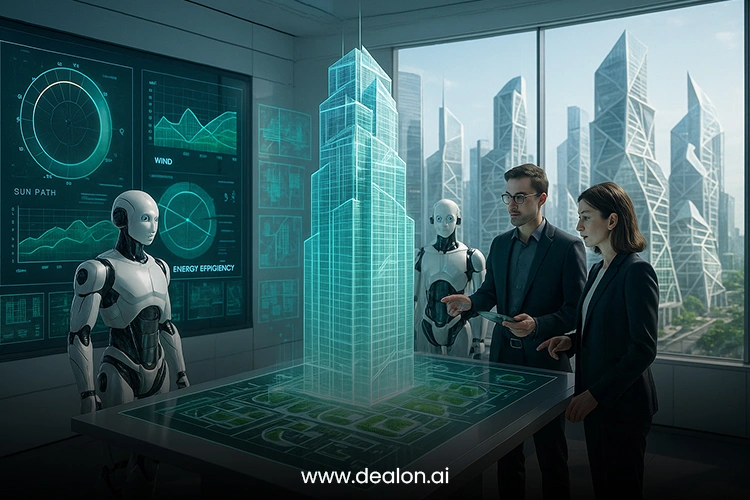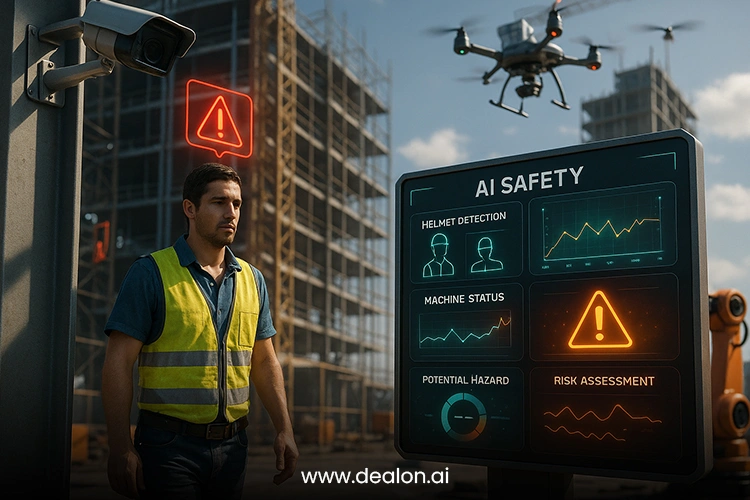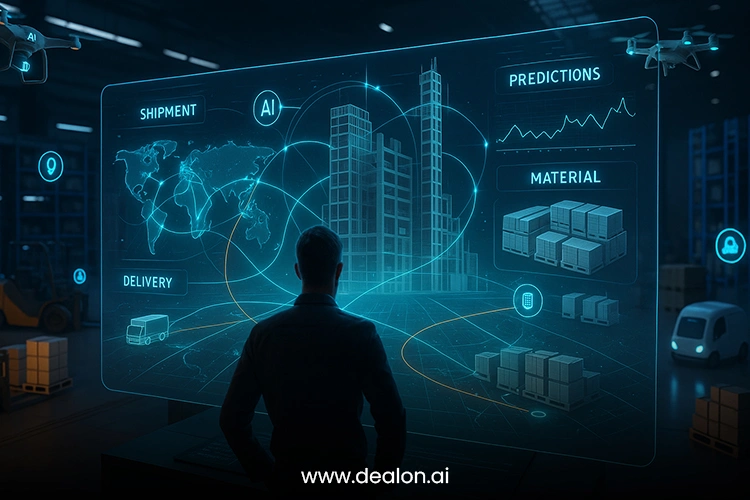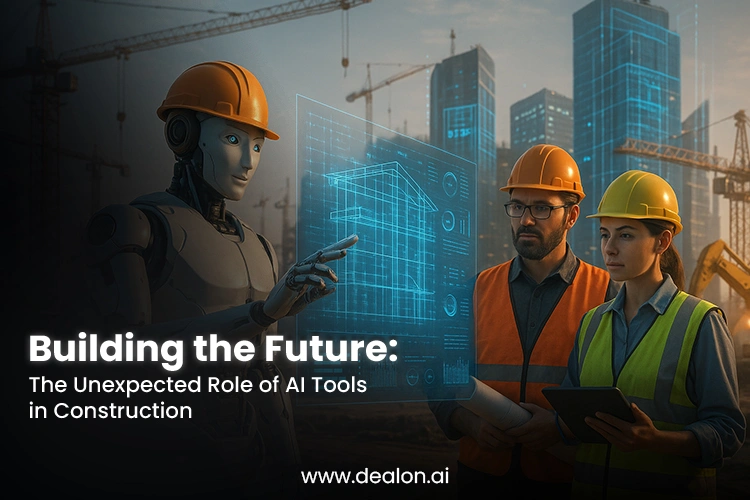Initially, construction was seen as a monotonous job involving a lot of manual work. But in recent times, this attitude towards construction is changing, especially with the introduction of AI tools. Although AI in Construction might have once been a mere fantasy, it is essential in the present times when it comes to the designing, building, and maintaining of structures. AI tools are streamlining processes, enhancing safety, predicting construction results, and taking over repetitive tasks. These are just a few among the many abundant examples of AI tools in construction.
Unlike in earlier times when construction professionals lacked modern tools and technology, today the industry is evolving, marking a new and improved era in construction history. AI tools are assisting in improving efficiency and, most importantly, making insightful and data-backed decisions. From robust predictive analytics tools helping to schedule advanced methane recapture design systems to robotic tools alleviating repetitive work, the possibilities AI tools are offering to construction professionals are astounding.
AI construction technologies will undoubtedly continue to expand as we work toward building more intelligent cities alongside more sustainable construction practices. The application of AI tools to transform construction and even our perception of urban development is unparalleled. The integration of AI technologies in construction is not limited to the automation of dull, repetitive tasks. Instead, AI tools can optimize construction processes to deliver building solutions that demonstrate unprecedented levels of operational dynamism and energy efficiency.
This blog highlights the role of AI tools in construction, specifically focusing on how they are changing the domain, fostering new ideas and more innovative ways of construction. If you are in the construction industry, an architect, or a project manager, no doubt adopting AI tools in your practice will change the way you shape the world around and allow you to stay ahead in your practice.
Also Read: Approaching the AI Revolution: A Guide to Non-Tech Professionals in 2025
Artificial Design and Architecture by AI: Erecting Structures Intelligently From Scratch

AI is changing the world of architectural design in ways that were once considered impossible. In the past, the architectural design of buildings was almost an artistic endeavor where the plethora of the artist’s skills combined with technology blended in a limited frame of time. Although important, these definitions seldom approach the performance of a building to its optimum.
However, with the tools that artificial intelligence offers to an architect, they not only use their imagination, but also are able to save time and resources, which leads to the construction of sustainable buildings. AI design tools can now consider and evaluate a multiplicity of factors, including but not limited to use patterns, the environment, and historical buildings, to design proposals that are space and energy-efficient, thus reducing construction costs.
Tools that harness artificial intelligence apply machine learning to assess a building’s performance over a period of time. Thus, designers are able to modify numerous variables in real time to ensure that the building is functional, cost-effective, eco-friendly, and looks good. AI can determine a building’s response to certain climate variables and conditions, such as temperature, sunlight, and seasons. In addition, vehicles and pedestrians may have an impact on the design of entryways and the size of public spaces.
Programs such as Spacemaker and Autodesk Revit have gained immense value through spatial analysis and design coupled with functional and environmental analysis. For instance, Spacemaker AI assists urban planners in making informed and responsible planning decisions by considering noise, sunlight, wind, and environmental policy. If used in the design stage, such information helps the architect design buildings of the future, which would not only be sustainable but, more importantly, would be in harmony with their environment as well as the future users.
Forecasting project time, expenses, and resources is one of the construction industry’s most persistent problems. AI assists in predictive analytics by attempting to streamline construction resource allocation. Delays, budget excesses, and a sudden lack of resources all plague construction’s complex nature. If construction managers could anticipate such roadblocks, expensive blunders could be avoided, thanks to project managers taking agile changes. When forecasting inaccuracies in resource allocation, machine learning from past construction, historical, and seasonal weather, and supply chains, expensive resources are proposed.
AI is also used in predictive analytics to improve the effectiveness of entire workforces. AI systems can determine how many workers and what skill sets are required for the specific tasks at specific times by evaluating historical and real-time data concerning productivity at construction sites.
This optimizes the productivity of the construction workforce by reducing idle working time as well as the unnecessary presence of workers lacking required skills. Since AI is able to provide real-time forecasts of resources, managers are able to maintain optimal staffing levels at all times, eliminating delays in construction work caused by insufficient workforce availability.
AI’s Impact on Predictive Risk Management and Hazard Prevention

Construction is an industry that deals with significant risk. Exposed to noisy and dangerous machinery, unpredictable site conditions, and performing heavy lifting, construction workers should always prioritize safety. The integration of AI with construction site safety is cutting down construction risks in ways that previously seemed unattainable.
With construction tech, firms can find and address problems before they cause harm. The ability to resolve these issues has evolved into AI systems that address conditions that make sites inherently dangerous. These systems employ AI, computer vision, and sensors to pinpoint hazardous situations on a construction site and flag them.
Suppose a worker is currently exposed to a situation where they are operating without a helmet and gloves. The specific AI tools that utilize computer vision are designed to issue alert notifications for such working conditions to streamline safety procedures. Similarly, AI tools are capable of monitoring machine operations for abnormal functioning, degrading conditions, or malfunctions. The autonomous system can be designed to identify situations that, in the absence of intervention, may easily lead to accidents caused by faulty equipment. The machine in question will be instantly shut down when it is detected operating unsafely.
Furthermore, AI devices are essential in construction site safety. For instance, drones can perform construction site aerial surveys. This includes risky inspections, such as building facades and roof structures, where workers have to deal with dangerous heights. This lowers inspections in hazardous conditions and falls. Drones use AI software to identify structural issues or weaknesses in some designs to check for unnoticed cracks in beams or walls. This prevents construction teams from safety issues and lowers injury headlines.
The role of AI safety goes beyond hazard detection to creating a culture of safety mindset by supporting proactive risk control. AI assists construction site safety by predicting possible accidents and spending minimal resources to avoid them. Integrating AI tools into construction work enables the prediction and resolution of issues before they happen. By integrating AI tools into construction work, construction companies are in a position to improve their safety culture. This, in turn, lowers the injury of the workers.AI in Robotics: automating labor-intensive tasks.
AI-powered robotics is constantly transforming productivity at construction sites by automating workflows. Firms now enjoy added efficiency, precision, and safety by automating repetitive and labor-intensive tasks using AI. Profitability, productivity, and consistent output are at an all-time high because robotics and AI seamlessly integrate. Human error and labor expenses are both significantly reduced.
A pertinent instance of AI robotics construction models is the Fastbrick Robotics Hadrian X, an AI-enabled robotic bricklaying machine that innovatively amplifies construction speed and precision. When employing Hadrian X, construction manual labor is significantly decreased. Hadrian X’s AI algorithms and robotic arms work together to lower construction timelines. Moreover, the system maintains structural integrity with high accuracy during brick placement. In addition to expense reduction and construction, the system reduces the risk of repetitive motion injuries that are common during brick placement.
As with other domains, artificial intelligence (AI) technology also drives robots doing critical work on construction sites. These robots handle welding with AI systems, revealing astonishing accuracy in welding individual components with a minimal probability of defects and with the certainty that joints are welded together.
Automating logistics while lowering the effort required of manual laborers is achieved with AI systems in construction, as they handle the automated transport of materials to and from different locations on the construction sites. This enables human laborers to channel their mental energy and time on planning and implementing more sophisticated and novel maneuvers, instead of repetitive, monotonous, and manual work.
AI technology, coupled with other systems, is also saving workers a lot of time and danger by handling the inspection and surveying of the sites and construction with drones later. These drones, coupled with their AI, compute a lot of information and can create a few pictures and videos of the terrain and analyze it to determine whether there are problems that are unseen by the eye, whether it is a defect or a danger.
As a result, it enables the human workers to automate the tedious and dangerous actions of climbing the construction site to inspect it, as well as numerous scaffolds. Besides, in construction, surveying robots are crucial as they are able to create 3D models of the terrain, which help in estimating progress, readiness, and action so that problems become visible.
AI in Construction Supply Chain Management

The construction supply chain is one of the more intricate and complex parts of the industry. The task of organizing the sourcing of raw materials, driving to the construction site, and coordinating their delivery at different construction progress points is very complicated and requires skill and efficiency. The construction supply chain becomes increasingly sophisticated and enables AI to work smarter. Construction businesses may reduce expenditure, enhance productivity, and achieve on-time delivery by automating resource allocation and logistics processes.
AI through designs of construction sites can use sensors and IoT devices to optimize material fulfillment by real-time monitoring of reordering, safe stocking, and auto-generation of requests, avoiding unwanted construction project delays. This level of monitoring precision eliminates the frequent issues associated with overstock and understock. Specifically, by reducing construction waste and reducing excess inventory waste, construction companies lower costs and improve their resource efficiency.
In addition, AI allows construction logistics to monitor and track materials and deliveries. Companies are now able to use AI to track and monitor the entire supply chain, ranging from the manufacturer to the construction site. The system advises in real time about the potential arrival disruptions and other logistics, including delays, transportation, and revised delivery schedules. With the assistance of AI, there is optimization of the routes and logistics for the purpose of delivery reliability and punctuality, and reduction of transportation and fuel costs.
With inventory levels so accurate now and having the ability to predict logistics so effectively, the supply chain can be automated to a greater extent, which allows for real-time project management to be set up, which can proceed with the project without having to micromanage. The project can be run smoothly without having to worry about the needless loss of profits.
The Future of Construction: Intelligent Cities Enhanced by AI
The implementation of digital technologies, improving city infrastructure, minimizing impacts on ecosystems, and maximizing the quality of life results in the formulation of smart cities. This phenomenon is the reality as AI is transforming urban planning and construction by having advanced techniques of construction, efficient resource management, and developed environmentally friendly practices. Due to the tremendous advancement of AI, the cities of the future will have all their buildings and roads integrated with advanced AI to enhance the safety of the environment.
AI goes beyond the construction of buildings when talking about smart cities. AI makes possible the development of entire cityscapes on a smarter level. For AI systems, real-time data from sensors embedded on city infrastructure can be analyzed to optimize the management of urban transport and public systems. Using AI will improve the design of comprehensive city management by integrating sustainable mechanisms that rely on observing movement patterns to modify infrastructure.
In the future, AI could operate autonomous vehicles, which would enhance the efficiency of city transport and reduce road congestion. For example, AI sensors can detect when a trash bin is full so that it can signal to waste sorting robots to perform more efficiently, lowering the volume of waste that lands in landfills. All of these processes can contribute to a cleaner urban setting as pollution and waste output are reduced.
AI-augmented infrastructure will let buildings and cities move and respond to changes more logically and responsively. Using embedded sensors and AI systems to predict wear and tear will allow maintenance to be more adaptable and done before expensive breakdowns and safety hazards. This will improve cost-effectiveness and overall maintenance expense. Furthermore, it will extend the overall structure efficiency and increase lifespan. AI will increase design flexibility as well as redefine cities.
On the other hand, more urban centers will become equipped with AI devices, and thus cities will become safer. With the ability to dynamically respond to population needs, urban centers will increase both efficiency and quality of life. Collection, The potential in urban development AI provides for creative methods of modern issues is unprecedented. This offers untouched area issues with rapid urbanization, keeping the environment, urbanization, and resource allocation in mind. Overcoming Challenges: Implementing AI in Construction
Implementation of AI in construction comes with its own hurdles, despite the evident benefits. The most significant barrier to the use of AI in construction is the exorbitant costs associated with its use. For instance, construction companies with low profit margins or smaller construction firms will find the hardware, software, maintenance, and training costs on AI-driven construction tools exorbitant and prohibitive.
Although AI tools are costly, the associated costs are anticipated to decline with the rise in prevalence and sophistication of AI technology. The decline in expenses will make such tools feasible and accessible even to companies working with smaller profit margins. Furthermore, over time, the return on investment from the optimization of streamlined processes in construction management and the reduction of delays and labor associated with the use of AI will justify the initial expense of purchasing such tools.
In addition to the problems above, the absence of appropriate and focused training programs also remains a concern. The plethoric use of AI construction tools will remain underutilized unless the required training is conducted. Training programs should be in collaboration with AI software providers and should tailor their teachings toward the tools that construction companies are using. Construction firms will be able to maximize the value of AI tools, equipped with a proactive upskilling approach.
Lastly, reluctance to change poses a still formidable barrier to entry in the construction market, in which the incorporation of “newfangled” ideas has flourished over the last while, but the essence stays the same: “old ways are the best ways.” Within the construction realm, numerous professionals resist adopting many of the modern workflow paradigms.
Acclimating to this reality, the emphasis should lie in stepwise advancement to full automation, which, in this case, AI, can begin automation for mundane, repetitive, highly numerous, and minute tasks efficiently so it can start projects to gain traction and finish managing workflows and build a certain level of confidence to the user for the program so it can achieve higher autonomy. AI, over time, will help in establishing industry workflows and will become the bedrock of the industry.
Conclusion
AI, along with other technologies, lays the foundation for the construction industry of the new age, driving efficiency, safety, and sustainability in previously unfathomable ways. The construction industry should brace itself for the increased ease and efficiency that will come from fully integrating other technologies and establishing synergies between them. If there is to continue to be any relevance in today’s interconnected systems and networked construction in an overly competitive industry, embracing AI today is vital.

